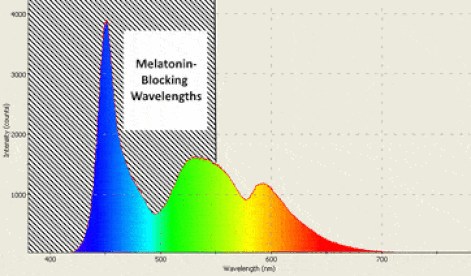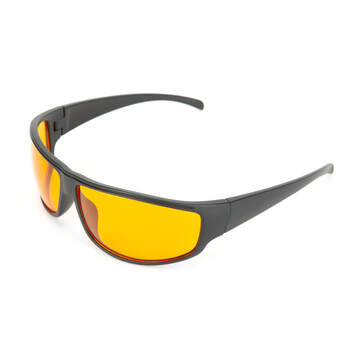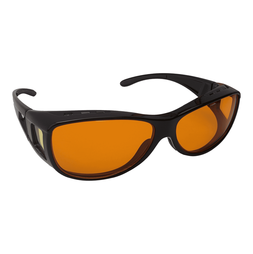Blue Light Insomnia:
How Blue Light from Smartphones, Computer Screens,
and Room Lighting are Disrupting Your Sleep
“Compared with dim light, exposure to room light before bedtime suppressed melatonin, resulting in a later melatonin onset in 99.0% of individuals and shortening melatonin duration by about 90 min.”--Gooley, et al. 2010.
Light is the Primary Regulator of the Circadian Rhythm
While sleep specialists have long known that light plays some role in regulating the Circadian Rhythm (the 24-hour cycle of sleep and wakefulness), recent studies have confirmed that light exposure is almost exclusively responsible for the regulation of sleep cycles. A 1996 experiment concluded that, “the timing of periodic behavioral stimuli, such as sleep, sedentary activity, social contacts and food intake are relatively weak circadian synchronizers in humans and provides further evidence that exposure to light is the primary synchronizer of the human circadian pacemaker” (Duffy, Kronauer, and Czeisler). However, a 2009 study by Bukhard and Phelps definitively concluded that “all wavelengths of light are not equal to their effects on the circadian clock network of the brain: it is predominately blue light that is most affective, as reflected experimentally by melatonin production.” According to George C. Brainard, director of the Light Research Program at Jefferson Medical College of Thomas Jefferson University, “Across 10 published studies on humans, rodents, and monkeys, the peak sensitivity” to melatonin reduction “appears to span 459–485 nm [blue wavelengths of light]” (qtd in Holzman 26). In fact, a separate experiment in 2005 demonstrated that application of even bright (800 lux) amber light (greater than 530 nm) had no negative effect on melatonin production (Kayumov et al).
Blue Light Blocks Melatonin Production and Disrupts Sleep
Beginning in the mid-1960s, studies began to reveal the capacity of light (and blue light, in particular) to block production of the essential sleep hormone melatonin. However, it wasn’t until the past decade that researchers have discovered the full effect of even moderate light levels on melatonin production and sleep. A 2011 study found that “Compared with dim light, exposure to room light before bedtime suppressed melatonin, resulting in a later melatonin onset in 99.0% of individuals and shortening melatonin duration by about 90 min. Also, exposure to room light during the usual hours of sleep suppressed melatonin by greater than 50% in most (85%) trials” (Gooley, et al). In a 2000 study, researchers were surprised to find that exposure to as little as 100 lux of ordinary light (equivalent to an average reading lamp) resulted in a 50% decrease in melatonin production, forcing them to conclude that “the human circadian timing system is approximately a log unit more sensitive to light than was previously thought” (Zeitzer, et al).
Even Small Doses of Blue Light at Night Block Melatonin
While it has long been recognized that lengthy exposure to bright light can delay sleep, recent evidence suggests that even short exposure to blue wavelengths of light, such as experienced when turning on a bathroom light in the middle of the night, can result in significant melatonin and sleep disruption. According to an experiment from November, 2000, “intermittent light exposure, even to as little as repeated 5-min intervals of bright light, can produce circadian resetting effects nearly as great as those observed with a continuous 5-h bright-light exposure. These findings… indicate that the brief intermittent exposures to bright light that we typically experience in everyday life may have a much greater impact on circadian entrainment than was previously recognized. Given that photic resetting responses can also be achieved in humans at much lower light intensities, these data suggest that sporadic nocturnal light exposure…may have more of an adverse circadian phase-shifting effect than previously anticipated” (Rimmer, et al).
Blue Blocking Amber Lenses and Sleep Lamps Allow Healthy Melatonin Production
Recent studies have attempted to mitigate the negative effects of nighttime blue light exposure through the use of blue-light blocking amber glasses and amber sleep lamps. A 2005 experiment used amber glasses to block blue wavelengths of light during simulated shift work. The researchers concluded: “All subjects demonstrated preserved melatonin levels in filtered light similar to their dim-light secretion profile. Unfiltered bright light drastically suppressed melatonin production. Normalization of endogenous melatonin production while wearing [amber] goggles did not impair measures of performance, subjective sleepiness, or alertness” (Kayumov et al). A separate 2009 study by Bukhard and Phelps found that simply wearing special amber glasses for 2-3 hours before bed increased sleep quality and subjective mood. Bukhard and Phelps conclude, “If subsequent studies confirm efficacy, the cost/benefit and risk/benefit ratios of these glasses as a potential treatment would be dramatic, substantially exceeding those of existing treatments. Moreover, if amber lenses create a “virtual darkness” sufficient to increase total melatonin production, their use may apply to realms as disparate as cancer prevention (Blask, 2009), control of premenstrual symptoms (Barron, 2007), and mood disorders.”
Teens and Screens: Blue Light Hazards from Phones, Tablets, and Laptops
Increasingly, teenagers are becoming avid night owls, leading to a host of sleep disorders and other health risks. According to a 2014 study, this increase in sleep disorders among teenagers can be traced “to the frequent and maybe inappropriate use of light-emitting and alerting multimedia screens before sleep onset during adolescence.” According to the study, blue blocking sleep glasses "therefore have the potential to acutely impede the negative effects modern lighting imposes on circadian physiology in the evening. The impact on the circadian system implicates that multimedia screen use may be harmful for adolescents’ health also in the long run and that blue blocking glasses could serve as a countermeasure with beneficial effects on sleep quality, daytime functioning, and even mood” (Lely, et al., 2014).
Find out more about Melatonin and Cancer or Night Shifts, Melatonin, and Health.
Learn more about ADHD insomnia or Bipolar Insomnia here.
Purchase amber sleep glasses, amber book lights, sleep lamps, red night lights, and amber nursery lamps here.
Find out more about Melatonin and Cancer or Night Shifts, Melatonin, and Health.
Learn more about ADHD insomnia or Bipolar Insomnia here.
Purchase amber sleep glasses, amber book lights, sleep lamps, red night lights, and amber nursery lamps here.
Sources:
Burkhard, K. & Phelps, J.R. (2009). Amber lenses to block blue light and improve sleep: A randomized trial. Chronobiology International, 26 (8), 1602-1612.
Gooley, J. J., Chamberlain, K., Smith, K. A., Khalsa, S. B. S., Rajaratnam, S. M. W., Van Reen, E., … Lockley, S. W. (2011). Exposure to Room Light before Bedtime Suppresses Melatonin Onset and Shortens Melatonin Duration in Humans. The Journal of Clinical Endocrinology and Metabolism, 96(3), E463–E472. doi:10.1210/jc.2010-2098
Duffy, J.F. and Czeisler, C.A. (2009). Effect of Light on Human Circadian Physiology. Sleep Med Clin., (2), 165-177.
Jamie M Zeitzer, Derk-Jan Dijk, Richard E Kronauer, Emery N Brown, Charles A Czeisler
J Physiol. Sensitivity of the human circadian pacemaker to nocturnal light: melatonin phase resetting and suppression. 2000 August 1; 526(Pt 3): 695–702. doi: 10.1111/j.1469-7793.2000.00695.x PMCID: PMC2270041.
Gooley, J. J., Chamberlain, K., Smith, K. A., Khalsa, S. B. S., Rajaratnam, S. M. W., Van Reen, E., … Lockley, S. W. (2011). Exposure to Room Light before Bedtime Suppresses Melatonin Onset and Shortens Melatonin Duration in Humans. The Journal of Clinical Endocrinology and Metabolism, 96(3), E463–E472. doi:10.1210/jc.2010-2098
Duffy, J.F. and Czeisler, C.A. (2009). Effect of Light on Human Circadian Physiology. Sleep Med Clin., (2), 165-177.
Jamie M Zeitzer, Derk-Jan Dijk, Richard E Kronauer, Emery N Brown, Charles A Czeisler
J Physiol. Sensitivity of the human circadian pacemaker to nocturnal light: melatonin phase resetting and suppression. 2000 August 1; 526(Pt 3): 695–702. doi: 10.1111/j.1469-7793.2000.00695.x PMCID: PMC2270041.
Duffy, J.F., Kronauer, R.E., and Czeisler, C.A. (1996). Phase-shifting human circadian rhythms: influence of sleep timing, social contact and light exposure. Journal of Physiology 456 p.289-297.
Kayumov L, Casper RF, Hawa RJ, Perelman B, Chung SA, Sokalsky S, Shapiro CM (May 2005). "Blocking low-wavelength light prevents nocturnal melatonin suppression with no adverse effect on performance during simulated shift work". J. Clin. Endocrinol. Metab. 90 (5): 2755–61.
Lely, S., Frey, S. Garbazza, C., Wirz-Justince, A., Jenni, O., Steiner, R., Wolf, S., Cajochen, C., Bromundt, V., and Schnidt, C. (2015). Blue Blocker Glasses as a Countermeasure for Alerting Effects of Evening Light-Emitting Diode Screen Exposure in Male Teenagers. Journal of Adolescent Health 56, 113-119
Rimmer DW, Boivin DB, Shanahan TL, Kronauer RE, Duffy JF, Czeisler CA. Dynamic resetting of the human circadian pacemaker by intermittent bright light. Am J Physiol Regul Integr Comp Physiol. 2000 Nov;279(5):R1574-9.
PMID: 11049838
Kayumov L, Casper RF, Hawa RJ, Perelman B, Chung SA, Sokalsky S, Shapiro CM (May 2005). "Blocking low-wavelength light prevents nocturnal melatonin suppression with no adverse effect on performance during simulated shift work". J. Clin. Endocrinol. Metab. 90 (5): 2755–61.
Lely, S., Frey, S. Garbazza, C., Wirz-Justince, A., Jenni, O., Steiner, R., Wolf, S., Cajochen, C., Bromundt, V., and Schnidt, C. (2015). Blue Blocker Glasses as a Countermeasure for Alerting Effects of Evening Light-Emitting Diode Screen Exposure in Male Teenagers. Journal of Adolescent Health 56, 113-119
Rimmer DW, Boivin DB, Shanahan TL, Kronauer RE, Duffy JF, Czeisler CA. Dynamic resetting of the human circadian pacemaker by intermittent bright light. Am J Physiol Regul Integr Comp Physiol. 2000 Nov;279(5):R1574-9.
PMID: 11049838






